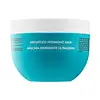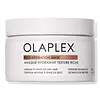What's inside
What's inside
 Key Ingredients
Key Ingredients

No key ingredients
 Benefits
Benefits

 Concerns
Concerns

 Ingredients Side-by-side
Ingredients Side-by-side

Water
Skin ConditioningCetearyl Alcohol
EmollientDimethicone
EmollientCanola Oil
EmollientParfum
MaskingBehentrimonium Methosulfate
Cetyl Alcohol
EmollientArgania Spinosa Kernel Oil
EmollientButyrospermum Parkii Butter
Skin ConditioningHydrolyzed Vegetable Protein Pg-Propyl Silanetriol
Skin ConditioningPEG-60 Almond Glycerides
EmulsifyingAcetamide Mea
HumectantButylene Glycol
HumectantCeteareth-20
CleansingBehentrimonium Chloride
PreservativeIsopropyl Alcohol
SolventSteareth-2
EmulsifyingPhenoxyethanol
PreservativeCaprylyl Glycol
EmollientChlorphenesin
AntimicrobialCitric Acid
BufferingEugenol
PerfumingButylphenyl Methylpropional
PerfumingHydroxyisohexyl 3-Cyclohexene Carboxaldehyde
MaskingLinalool
PerfumingAlpha-Isomethyl Ionone
PerfumingWater, Cetearyl Alcohol, Dimethicone, Canola Oil, Parfum, Behentrimonium Methosulfate, Cetyl Alcohol, Argania Spinosa Kernel Oil, Butyrospermum Parkii Butter, Hydrolyzed Vegetable Protein Pg-Propyl Silanetriol, PEG-60 Almond Glycerides, Acetamide Mea, Butylene Glycol, Ceteareth-20, Behentrimonium Chloride, Isopropyl Alcohol, Steareth-2, Phenoxyethanol, Caprylyl Glycol, Chlorphenesin, Citric Acid, Eugenol, Butylphenyl Methylpropional, Hydroxyisohexyl 3-Cyclohexene Carboxaldehyde, Linalool, Alpha-Isomethyl Ionone
Water
Skin ConditioningCetearyl Alcohol
EmollientDodecane
PerfumingC10-18 Triglycerides
EmollientBehentrimonium Methosulfate
Propanediol
SolventBehentrimonium Chloride
PreservativeHelianthus Annuus Seed Oil
EmollientPersea Gratissima Oil
Skin ConditioningBrassicamidopropyl Dimethylamine
Skin ConditioningGlycerin
HumectantHydrogenated Rapeseed Oil
EmollientMyristyl Myristate
EmollientCarthamus Tinctorius Seed Oil
MaskingBrassica Glycerides
EmollientButyrospermum Parkii Butter
Skin ConditioningCocos Nucifera Oil
MaskingCrambe Abyssinica Seed Oil
Skin ConditioningDioctyldodecyl Dodecanedioate
EmollientHydrogenated Castor Oil/Sebacic Acid Copolymer
EmollientPropylheptyl Caprylate
EmollientEthyl Oleate
EmollientParfum
MaskingStyrene/Butadiene Copolymer
Phenoxyethanol
PreservativeQuaternium-87
CleansingIsopropyl Alcohol
SolventLactic Acid
BufferingGuar Hydroxypropyltrimonium Chloride
Skin ConditioningCaprylic/Capric Triglyceride
MaskingCeratonia Siliqua Gum
EmollientPropylene Glycol
HumectantMaltodextrin
AbsorbentChlorphenesin
AntimicrobialEthylhexylglycerin
Skin ConditioningBis-Aminopropyl Diglycol Dimaleate
Skin ConditioningSclerotium Gum
Emulsion StabilisingArginine
MaskingSilybum Marianum Seed Extract
Skin ConditioningSuccinic Acid
BufferingTrisodium Ethylenediamine Disuccinate
Hexyl Cinnamal
PerfumingLimonene
PerfumingCitral
PerfumingOlea Europaea Leaf Extract
PerfumingPentaerythrityl Tetra-Di-T-Butyl Hydroxyhydrocinnamate
AntioxidantTocopherol
AntioxidantSodium Benzoate
MaskingTbhq
AntioxidantSodium Hydroxide
BufferingCI 19140
Cosmetic ColorantCI 15985
Cosmetic ColorantWater, Cetearyl Alcohol, Dodecane, C10-18 Triglycerides, Behentrimonium Methosulfate, Propanediol, Behentrimonium Chloride, Helianthus Annuus Seed Oil, Persea Gratissima Oil, Brassicamidopropyl Dimethylamine, Glycerin, Hydrogenated Rapeseed Oil, Myristyl Myristate, Carthamus Tinctorius Seed Oil, Brassica Glycerides, Butyrospermum Parkii Butter, Cocos Nucifera Oil, Crambe Abyssinica Seed Oil, Dioctyldodecyl Dodecanedioate, Hydrogenated Castor Oil/Sebacic Acid Copolymer, Propylheptyl Caprylate, Ethyl Oleate, Parfum, Styrene/Butadiene Copolymer, Phenoxyethanol, Quaternium-87, Isopropyl Alcohol, Lactic Acid, Guar Hydroxypropyltrimonium Chloride, Caprylic/Capric Triglyceride, Ceratonia Siliqua Gum, Propylene Glycol, Maltodextrin, Chlorphenesin, Ethylhexylglycerin, Bis-Aminopropyl Diglycol Dimaleate, Sclerotium Gum, Arginine, Silybum Marianum Seed Extract, Succinic Acid, Trisodium Ethylenediamine Disuccinate, Hexyl Cinnamal, Limonene, Citral, Olea Europaea Leaf Extract, Pentaerythrityl Tetra-Di-T-Butyl Hydroxyhydrocinnamate, Tocopherol, Sodium Benzoate, Tbhq, Sodium Hydroxide, CI 19140, CI 15985
Ingredients Explained
These ingredients are found in both products.
Ingredients higher up in an ingredient list are typically present in a larger amount.
This ingredient is a preservative and often used for it's anti-static properties. You'll most likely see this ingredient in hair conditioners.
It does not cause irritation or sensitization in leave-on products at 1-5%.
Behentrimonium Methosulfate is an ammonium salt. It is mainly used to prevent static in haircare products as a surfactant.
Surfactants have differing ends: one side is hydrophilic while the other end is hydrophobic.
Surfactants also help your cleansers remove pollutants more easily from the skin.
Learn more about Behentrimonium MethosulfateThis ingredient is also known as shea butter. It is an effective skin hydrator and emollient.
Emollients help soothe and soften your skin. It does this by creating a protective film on your skin. This barrier helps trap moisture and keeps your skin hydrated. Emollients may be effective at treating dry or itchy skin.
Shea butter is rich in antioxidants. Antioxidants help fight free-radicals, or molecules that may harm the body. It is also full of fatty acids including stearic acid and linoleic acid. These acids help replenish the skin and keep skin moisturized.
While Shea Butter has an SPF rating of about 3-4, it is not a sunscreen replacement.
Shea butter may not be fungal acne safe. We recommend speaking with a professional if you have any concerns.
Learn more about Butyrospermum Parkii ButterCetearyl alcohol is a mixture of two fatty alcohols: cetyl alcohol and stearyl alcohol. It is mainly used as an emulsifier. Emulsifiers help prevent the separation of oils and products. Due to its composition, it can also be used to thicken a product or help create foam.
Cetearyl alcohol is an emollient. Emollients help soothe and hydrate the skin by trapping moisture.
Studies show Cetearyl alcohol is non-toxic and non-irritating. The FDA allows products labeled "alcohol-free" to have fatty alcohols.
This ingredient is usually derived from plant oils such as palm, vegetable, or coconut oils. There is debate on whether this ingredient will cause acne.
Due to the fatty acid base, this ingredient may not be Malassezia folliculitis safe.
Learn more about Cetearyl AlcoholChlorphenesin is a synthetic preservative. It helps protect a product against bacteria in order to extend shelf life. In most cases, Chlorphenesin is paired with other preservatives such as phenoxyethanol and caprylyl glycol.
Chlorphenesin is a biocide. This means it is able to help fight the microorganisms on our skin. It is also able to fight odor-releasing bacteria.
Chlorphenesin is soluble in both water and glycerin.
Studies show Chlorphenesin is easily absorbed by our skin. You should speak with a skincare professional if you have concerns about using Chlorphenesin.
Learn more about ChlorphenesinIsopropyl Alcohol is more commonly known as rubbing alcohol. It is most commonly used as a solvent, meaning it helps other ingredients dissolve.
This ingredient is an astringent alcohol. Astringent alcohols may also irritate skin as they high amounts may strip away your skin's natural oils.
Other types of astringent alcohols include:
According to the National Rosacea Society based in the US, you should be mindful of products with these alcohols in the top half of ingredients.
Any type of sanitizing product will have high amounts of alcohol to help kill bacteria and viruses.
Learn more about Isopropyl AlcoholParfum is a catch-all term for an ingredient or more that is used to give a scent to products.
Also called "fragrance", this ingredient can be a blend of hundreds of chemicals or plant oils. This means every product with "fragrance" or "parfum" in the ingredients list is a different mixture.
For instance, Habanolide is a proprietary trade name for a specific aroma chemical. When used as a fragrance ingredient in cosmetics, most aroma chemicals fall under the broad labeling category of “FRAGRANCE” or “PARFUM” according to EU and US regulations.
The term 'parfum' or 'fragrance' is not regulated in many countries. In many cases, it is up to the brand to define this term.
For instance, many brands choose to label themselves as "fragrance-free" because they are not using synthetic fragrances. However, their products may still contain ingredients such as essential oils that are considered a fragrance by INCI standards.
One example is Calendula flower extract. Calendula is an essential oil that still imparts a scent or 'fragrance'.
Depending on the blend, the ingredients in the mixture can cause allergies and sensitivities on the skin. Some ingredients that are known EU allergens include linalool and citronellol.
Parfum can also be used to mask or cover an unpleasant scent.
The bottom line is: not all fragrances/parfum/ingredients are created equally. If you are worried about fragrances, we recommend taking a closer look at an ingredient. And of course, we always recommend speaking with a professional.
Learn more about ParfumPhenoxyethanol is a preservative that has germicide, antimicrobial, and aromatic properties. Studies show that phenoxyethanol can prevent microbial growth. By itself, it has a scent that is similar to that of a rose.
It's often used in formulations along with Caprylyl Glycol to preserve the shelf life of products.
Water. It's the most common cosmetic ingredient of all. You'll usually see it at the top of ingredient lists, meaning that it makes up the largest part of the product.
So why is it so popular? Water most often acts as a solvent - this means that it helps dissolve other ingredients into the formulation.
You'll also recognize water as that liquid we all need to stay alive. If you see this, drink a glass of water. Stay hydrated!
Learn more about Water